Bhushan B. Handbook of Micro/Nano Tribology, Second Edition
Подождите немного. Документ загружается.

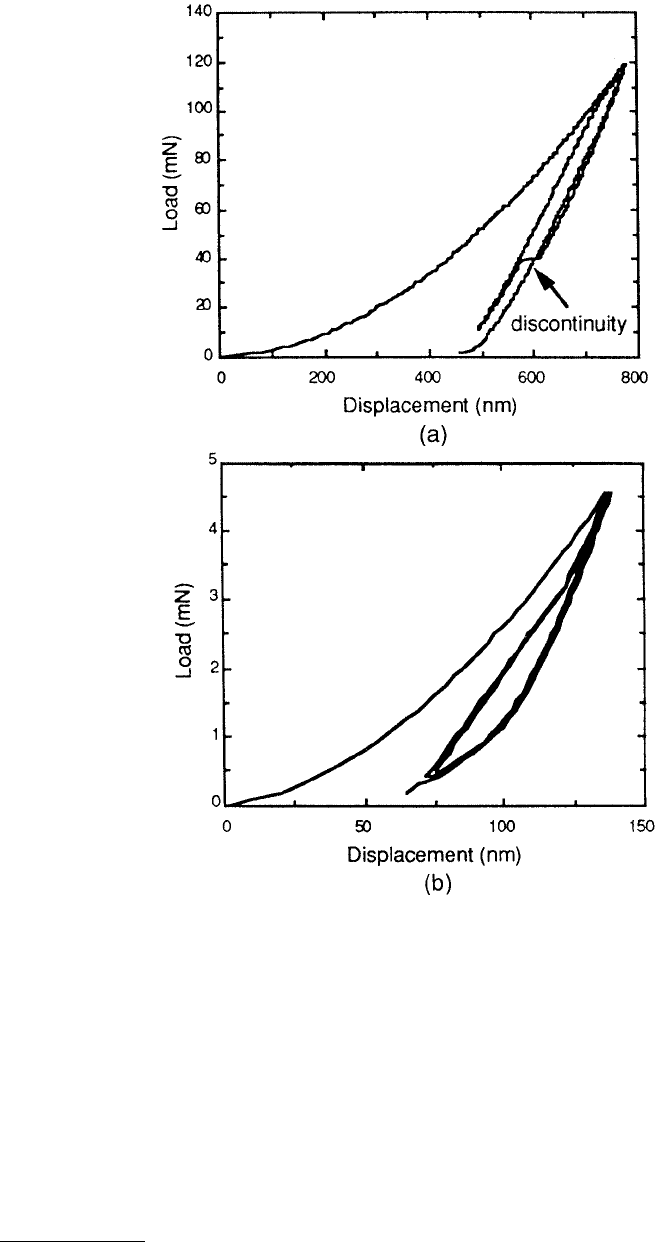
© 1999 by CRC Press LLC
were detected occasionally. However, no AE signals were detected during the distinct load–displacement
discontinuity on unloading which is seen in Figure 10.42a at 60 mN. Since no emission was detected,
the source of the discontinuity is more likely to be a sluggish transformation (Hu et al., 1986; Clarke
et al., 1988; Pharr, 1992) than a rapid crack growth.
Gupta et al. (1993, 1994) and Gupta and Bhushan (1994) reported that hysteresis in cyclic indentation
and discontinuity kinks in the unloading curve are considerably reduced by ion implantation of com-
pound forming species 0
+
and N
+
into single-crystal silicon. They further reported that amorphous silicon
films did not exhibit either hysteresis in the cyclic indentation or a discontinuity kink in the indentation
loads ranging from 1 to 90 mN. This suggests that for a perfect amorphous structure, the hysteresis does
FIGURE 10.40 Load vs. displacement plots for (110) silicon (a) at a peak load of 120 mN and (b) at a peak load
of 4.5 mN. (From Pharr, G.M., 1992, in Thin Film: Stresses and Mechanical Properties III, W.D. Nix et al., eds., Vol. 239,
pp. 301–312, Materials Research Society, Pittsburgh. With permission.)
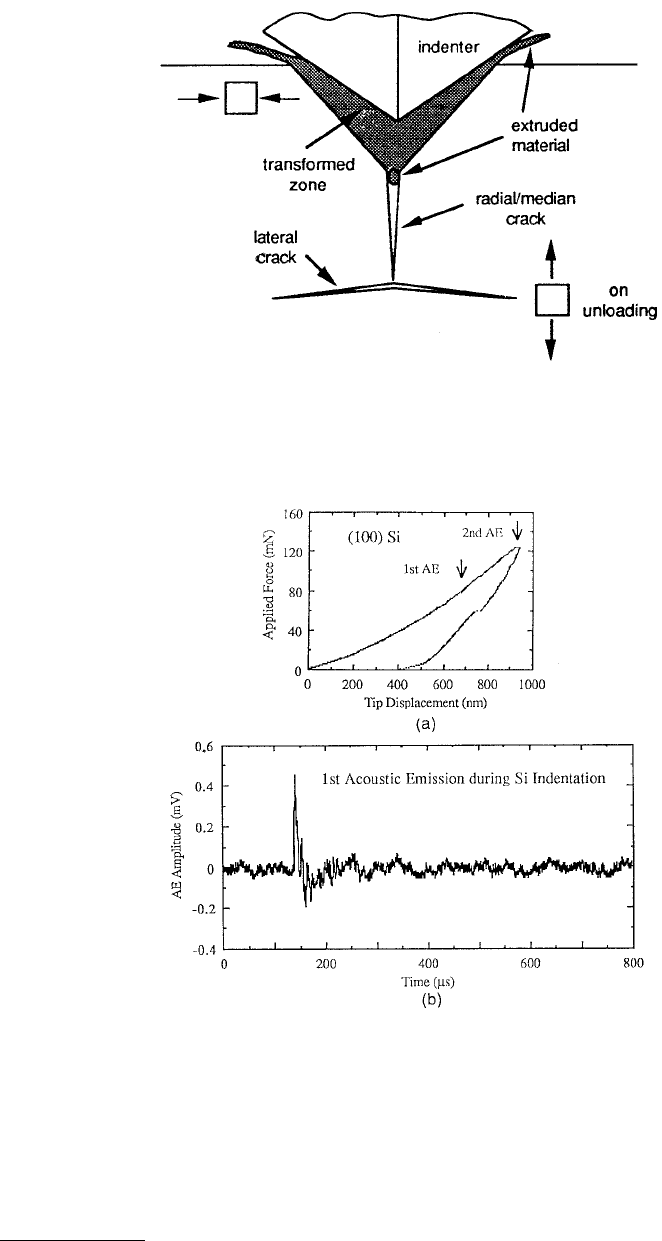
© 1999 by CRC Press LLC
not occur because of absence of crystallographic pressure-induced phase transition during cyclic loading
and unloading. In addition, the disordered structure does not allow the nucleation and propagation of
the lateral cracks beneath the indentation. They have also reported that ion implantation has an insig-
nificant effect on hardness and elastic modulus. Improvement in the hardness is about 10% as a result
FIGURE 10.41 A schematic illustration of the coupling of the phase transformation and cracking during indenta-
tion of single-crystal silicon. (From Pharr, G.M., 1992, in Thin Film: Stresses and Mechanical Properties III, W.D. Nix
et al., eds., Vol. 239, pp. 301–312, Materials Research Society, Pittsburgh. With permission.)
FIGURE 10.42 (a) Applied force as a function of tip displacement for Si(100) and (b) AE amplitude as a function
of time during loading. (From Weihs, T.P. et al., 1992, in Thin Films: Stresses and Mechanical Properties III, Symp.
Proc., W.E. Nix, et al., eds., Vol. 239, pp. 361–370, Materials Research Society, Pittsburgh. With permission.)
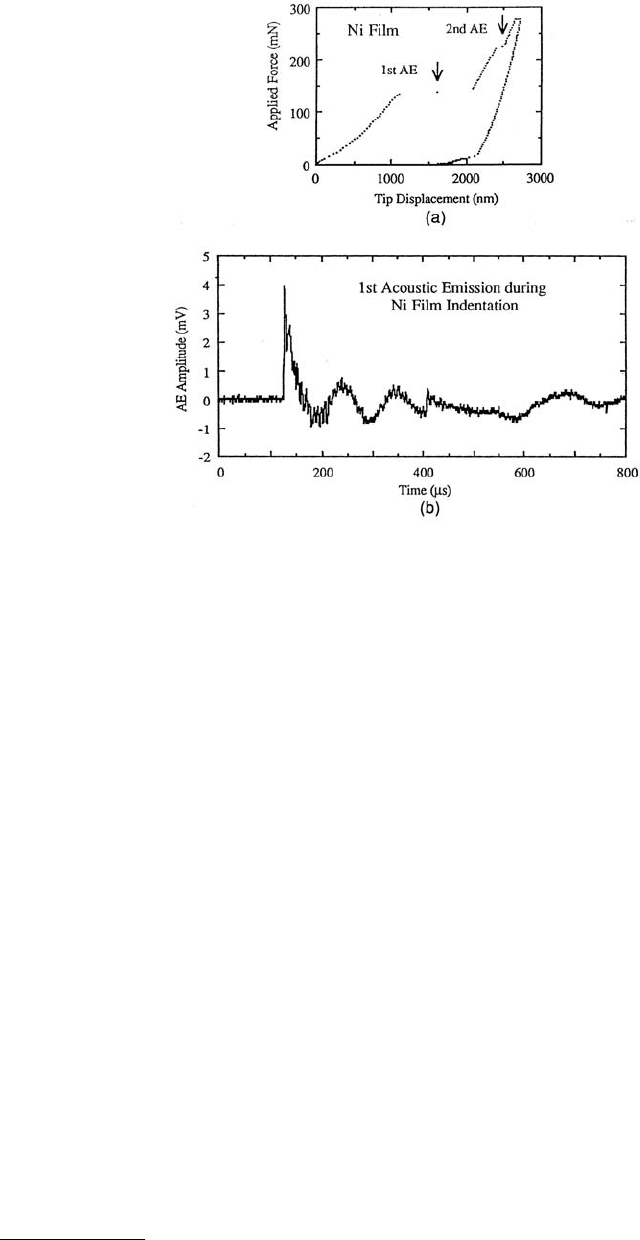
© 1999 by CRC Press LLC
of implantation with carbon and boron ions. Gupta et al. (1993, 1994) reported that ion-bombarded
silicon exhibits a very low coefficient of friction (~0.05) and a low wear factor (~10
–6
mm
3
N
–1
m
–1
) when
slid against alumina and 52100 steel balls.
Weihs et al. (1992) indented Ni films on a glass substrate. The Ni films debonded from their substrates
at forces ranging between 130 and 250 mN. The debonding events were marked by the indenter tip
jumping downward as “chunks” of the Ni film buckled away from the underneath. The indenter tip
jumped a distance equal to the film thickness as it initially debonded. Figure 10.43 also shows the
corresponding AE trace with a rise time of 1.8 µs. In this particular test, debonding continued at higher
forces and a second AE event was recorded. After each test, optical microscopy confirmed the delamina-
tion of the film from underneath the indenter.
Gupta and Bhushan (1995) indented 20-nm-thick amorphous carbon (a–C, also known as diamond-
like carbon or DLC) films deposited by four different deposition techniques, sputtered Al
2
O
3
and sput-
tered SiC films on Al
2
O
3
–TiC substrate, Figure 10.44. The indentation depths are larger than the film
thickness, which means that the tip had penetrated through the films into the substrate material during
the indentation process. Most of the films exhibit a discontinuity or pop-in marks in the loading curve,
shown by arrows in Figure 10.44, which indicate a sudden penetration of the tip into the sample. A
nonuniform penetration of the tip into a thin film possibly results due to formation of cracks in the film,
formation of cracks at the film–substrate interface, or debonding or delamination of the film from the
substrate. The Al
2
O
3
–TiC substrate exhibits a smooth loading curve free from any pop-in marks, which
indicates that a 0.5-mN peak indentation load is insufficient to damage the surface. All of the films
exhibited indentation depths at the peak load higher than that of the Al
2
O
3
–TiC substrate.
Oliver and Pharr (1992) have reported that load–displacement curves during unloading are not linear,
rather each unloading curve is slightly concave over its entire span. They showed that the unloading
FIGURE 10.43 (a) Applied force as a function of tip displacement for Ni film on glass substrate and (b) AE
amplitude as a function of time during loading. (From Weihs, T.P. et al., 1992, in Thin Films: Stresses and Mechanical
Properties III, Symp. Proc., W.E. Nix, et al., eds., Vol. 239, pp. 361–370, Materials Research Society, Pittsburgh. With
permission.)
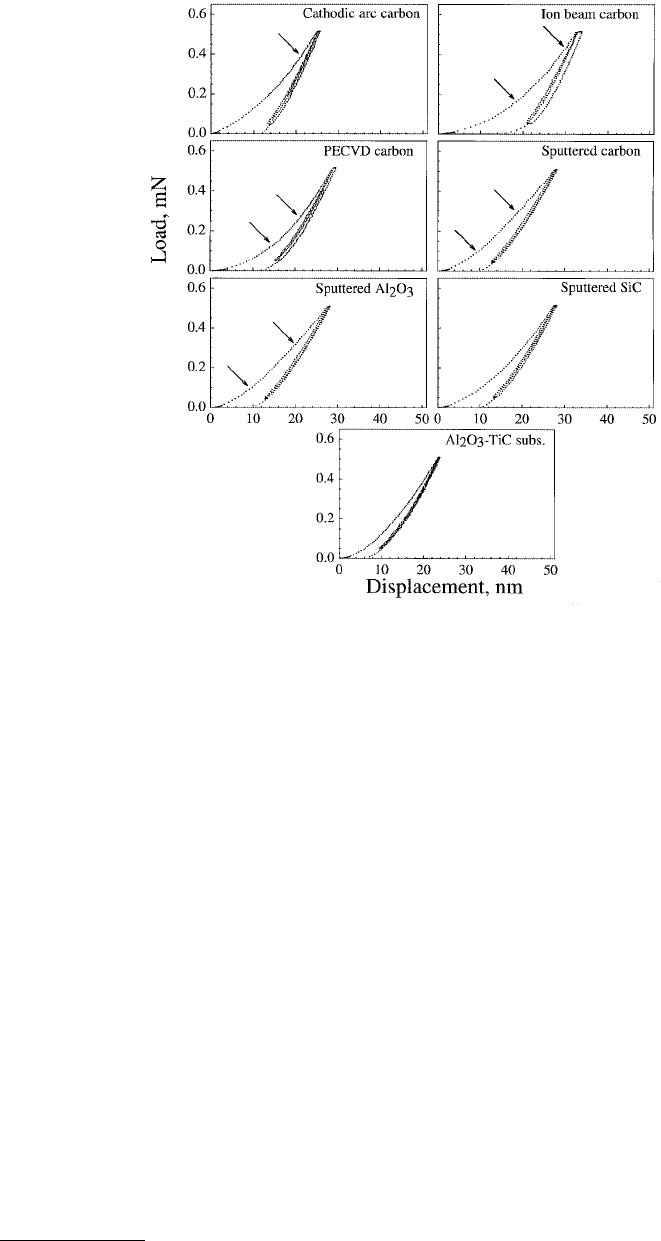
© 1999 by CRC Press LLC
curves are well described by a power law relation like that of Equation 10.7 presented earlier. For the six
materials tested, the exponents varied from 1.25 to 1.50 and were not distinctly greater than 1 which
implies that none of the data is consistent with flat punch behavior.
10.4.2 Continuous Stiffness Measurements
Continuous stiffness measurements are used for continuous measurement of sample stiffness or com-
pliance (related to elastic modulus) during indentation. Oliver and Pharr (1992) measured continuous
stiffness of electropolished single-crystal tungsten at low peak loads of 0.5 mN or less, for purely elastic
contact. Continuous stiffness data for the indentation data in Figure 10.37b are presented in Figure 10.45a.
Comparisons of these data with the load–time history, shown in Figure 10.35, show that the measured
contact stiffness and thus the contact area does increase and decrease in the way that would be expected
based on the loading history. The continuous stiffness data for the indentation at 1.5-mN load (plastic
contact, Figure 10.37c) is shown in Figure 10.45b. It is seen that for each of the four unloadings, the
contact stiffness changes immediately and continuously as the specimen is unloaded. Thus, the contact
area, which varies in that same way as the contact stiffness, is not constant during the unloading of the
plastic hardness impression, even during the initial stages of unloading.
10.4.3 Hardness and Elastic Modulus Measurements
Nanoindenter is commonly used to measure surface mechanical properties of bulk materials (Pharr et al.,
1990; Lucas et al., 1991; Oliver and Pharr, 1992; Bhushan and Gupta, 1995; Bhushan et al., 1996).
FIGURE 10.44 Load vs. displacement plots for various 20-nm-thick amorphous carbon films and ion beam–sput-
tered Al
2
O
3
and RF-sputtered SiC coatings on Al
2
O
3
–TiC substrate and bare Al
2
O
3
–TiC substrate. (From Gupta, B.K.
and Bhushan, B., 1995, Wear 190, 110–122. With permission.)
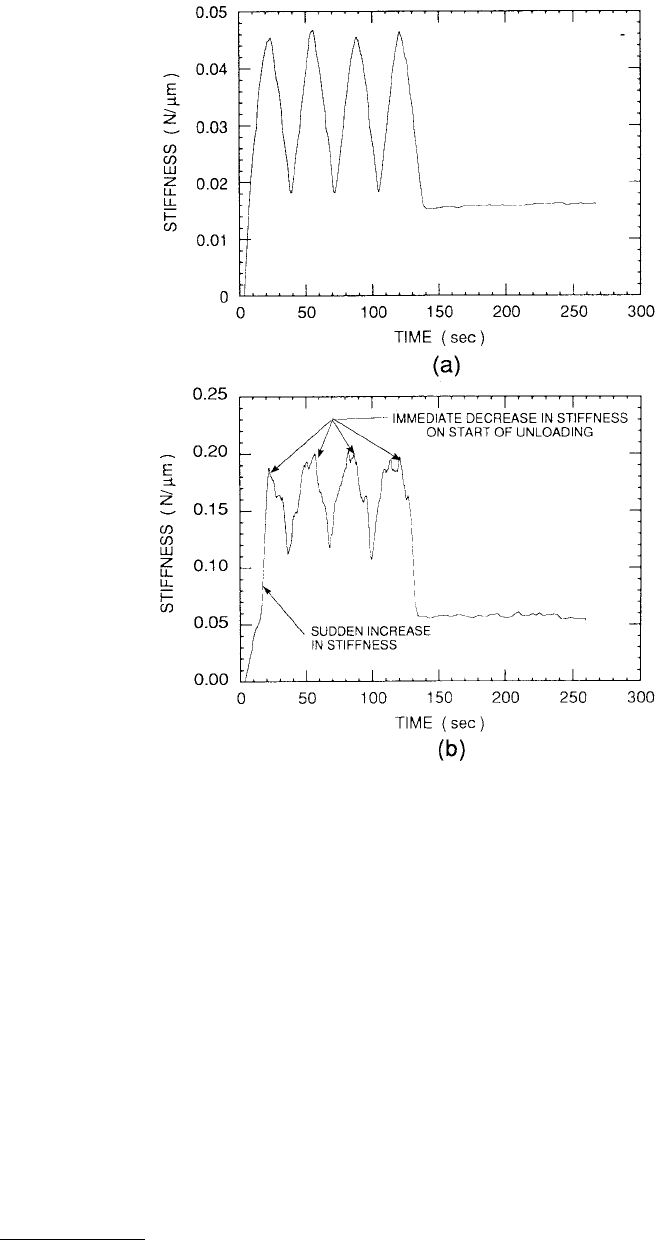
© 1999 by CRC Press LLC
Hardness and elastic moduli for six bulk materials and three materials used as a substrate for the
construction of magnetic rigid disks and single-crystal silicon are presented in Figure 10.46. The data
show that there is a very little indentation size effect in several materials on the hardness values. In the
case of aluminum and tungsten in Figure 10.46a, there is a modest increase in hardness at low loads.
According to Oliver and Pharr (1992), this could be due to surface-localized cold-work resulting from
polishing. The modulus data also show that there is very little evidence for an indentation size effect;
i.e., the moduli remains more or less constant over the entire range of load. Oliver and Pharr (1992)
reported that the hardness and modulus values at the two highest loads are comparable with the literature
values. Comparison of published values and measured values of magnetic disk substrates in Figure 10.46b
is shown in Table 10.4. (Fracture toughness data will be discussed later.)
Pharr et al. (1990) reported a nanoindentation hardness value of (110) single-crystal silicon to be
about 11.4 GPa at a peak normal load of 120 mN and corresponding peak indentation depth of 750 nm.
This value was slightly higher than the macrohardness value of silicon of 9 to 10 GPa (Anonymous, 1988).
Using an atomic force microscope, Bhushan and Koinkar (1994) measured hardness of single-crystal
FIGURE 10.45 Contact stiffness vs. time. (a) for a fully elastic contact and (b) for a fully plastic contact on an
electropolished single-crystal tungsten measured with the continuous stiffness technique. (From Oliver, W.C. and
Pharr, G.M., 1992, J. Mater. Res. 7, 1564–1583. With permission.)
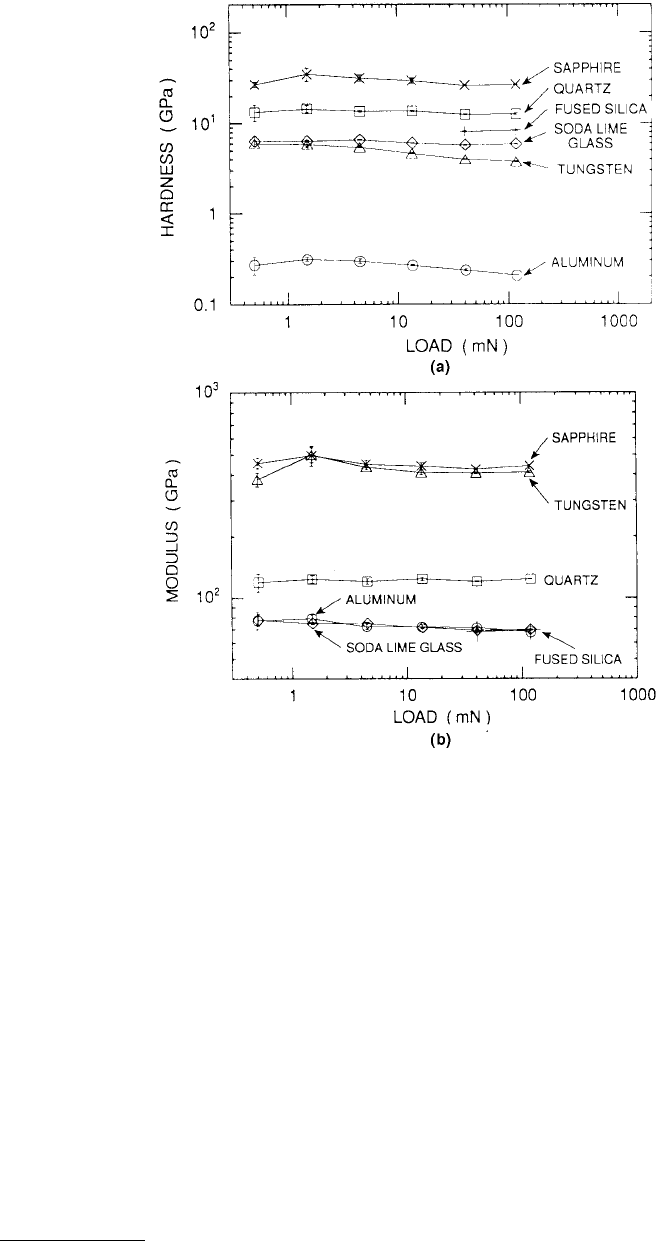
© 1999 by CRC Press LLC
silicon at an ultrasmall normal load of 65 µN and corresponding indentation depth of 2.5 nm and
reported a value of 16.6 GPa. It is clear that the hardness of silicon increases with a decrease in the load
and corresponding indentation depth. An increase in hardness at lower indentation depths may result
from contributions of the surface films. At smaller volumes, there is a high probability that indentation
would be made into a region that was initially dislocation free. Furthermore, at small volumes, there is
an increase in the stress necessary to operate dislocation sources (Gane and Cox, 1970; Sargent, 1986).
These are some of the plausible explanations for the increase in hardness at smaller volumes.
A number of investigators have used the nanoindenter to study the effect of ion implantation on the
hardness and elastic modulus of metals (Nastasi et al., 1988; Lee and Mansur, 1989; Bourcier et al., 1990,
1991; Was, 1990), silicon (Gupta et al., 1993, 1994; Gupta and Bhushan, 1994), ceramics (McHargue,
1989; McHargue et al., 1990; O’Hern et al., 1990; Was and DeKoven, 1991) and polymers (Lee et al.,
1992, 1993; Rao et al., 1993). Generally, the ion-implanted zone is shallow and the nanoindenter is capable
of measuring the changes in mechanical properties.
The nanoindenter is ideal for measurement of mechanical properties of thin films and composite
structures. A number of investigators have reported hardness of composite structures with thin films on
a substrate (Pethica et al., 1985; Burnett and Rickerby, 1987c; Stone et al., 1988; Wu et al., 1988, 1989,
1990b; O’Hern et al., 1989; Bhushan and Doerner, 1989; Jiang et al., 1989; Joslin et al., 1989; Baker et al.,
FIGURE 10.46
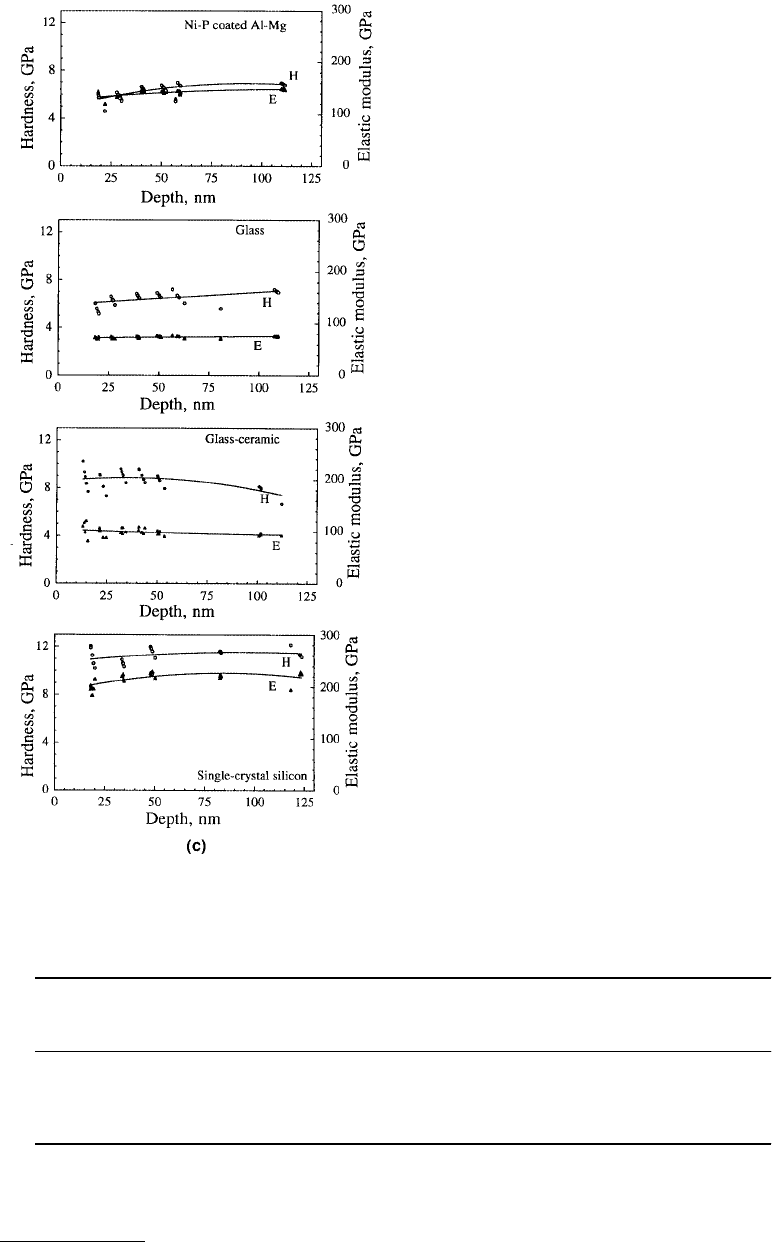
© 1999 by CRC Press LLC
FIGURE 10.46 Hardness and elastic modulus (a) as a
function of load for six bulk materials — mechanically
polished single-crystal aluminum, electropolished single-
crystal tungsten, soda lime glass, fused silica, (001) single-
crystal sapphire, and (001) single-crystal quartz (Oliver
and Pharr, 1992), and (b) as a function of indentation
depth (load ranging from 0.1 to 2.5 mN) for mechanically
polished 10-µm-thick electroless Ni–P film on Al–Mg
alloy 5086, chemically strengthened alkali-aluminosilicate
glass, chain silicate glass–ceramic (polycrystalline) (Can-
asite by Corning), and single-crystal silicon (111). (From
Bhushan, B. and Gupta, B.K., 1995, Adv. Info. Storage Syst.
6, 193–208. With permission.)
TABLE 10.4 rms Roughness Values Measured by an Atomic Force Microscope, Hardness and Elastic
Modulus Values Measured by Using a Nanoindenter (at an indentation depth of about 20 nm), and Fracture
Toughness Measured by Using a Vickers Microindenter
Material
rms
Roughness
(nm)
Hardness
a
(GPa)
Elastic
Modulus
b
(GPa)
Crack Length,
c (µm)
Fracture
Toughness
c
(MPa·m
1/2
)
Ni–P/Al–Mg 3.6 6.0 (5.5) 130 (200) No cracks —
Chemically strengthened glass 1.1 6.0 (5.8) 85 (73) Significant cracking — (0.9)
Glass–ceramic 6.1 8.5 (5.5) 100 (83) 59.4 0.65 (4.0)
Single-crystal silicon (111) 0.95 11.0 (9-10) 200 (180) — —
a
Values in parentheses are the reported values measured by conventional Vickers indentation method.
b
Values in parentheses are the reported values measured by conventional tensile pull test method.
c
Values in parentheses are the reported values measured by the chevron notched short bar method.
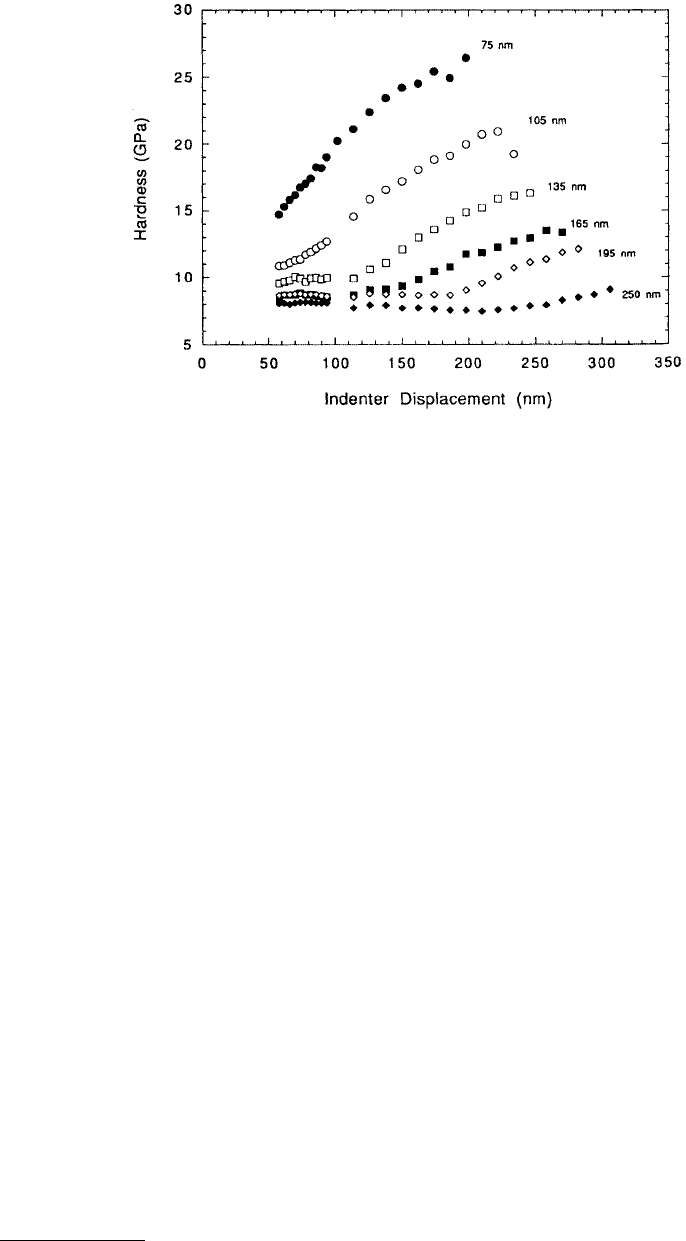
© 1999 by CRC Press LLC
1990; Bull and Rickerby, 1990; Cammarata et al., 1990; Cho et al., 1990; Cornett et al., 1990; Rubin et al.,
1990; Chou et al., 1991; Cooper, 1991; Cooper and Beetz, 1991; Gissler et al., 1991; Schlesinger et al.,
1991; Stone et al., 1991; Bhushan et al., 1992, 1995, 1997; Fabes et al., 1992; Knight et al., 1992; Lucas
and Oliver, 1992; Savvides and Bell, 1992; Wang et al., 1992; Whitehead and Page, 1992; Li et al., 1993;
Nastasi et al., 1993; Vancoille et al., 1993; Gupta and Bhushan, 1995a,b; Patton and Bhushan, 1996;
Bhushan and Li, 1997; Li and Bhushan, 1998b, c).
True hardness of the films can be obtained if the indentation depth does not exceed about 30% of the
film thickness. At higher indentation depths, the composite hardness changes with the indentation depth.
Measured hardness values of soft Ti films on a hard sapphire substrate are presented in Figure 10.47. We
note that hardness increases with a decrease in the film thickness or increase in the indentation depth,
as expected. The film hardness is the steady-state hardness independent of the indentation depth.
Hardness and elastic modulus profiles as a function of indentation depth at the peak load for 400-nm-
thick amorphous carbon films deposited by various deposition techniques, SiC films, and single-crystal
silicon substrates are presented in Figure 10.48. We note that the hardness and elastic modulus of cathodic
arc carbon and radio frequency (RF)-sputtered SiC films tend to decrease with the indentation depth,
which is attributed to increased contributions of the silicon substrate with a lower hardness of 11 GPa,
at larger depths. Cathodic arc carbon film exhibits the highest hardness of 38 GPa and elastic modulus
of 300 GPa as compared with that of other coatings. The high hardness and elastic modulus of cathodic
arc film are followed by RF-sputtered SiC, ion beam carbon, and plasma enhanced-chemical vapor
deposition/direct current (PECVD/DC) sputtered carbon films. High hardness and elastic modulus of
cathodic arc carbon film are attributed to the high kinetic energy of the carbon species involved in the
cathodic arc deposition. The differences in the hardness and elastic modulus of carbon films is attributed
to their varying sp
3
- to sp
2
-bonding ratio and the amount of hydrogen (Gupta and Bhushan, 1995a,b).
The hardness and elastic modulus data are summarized in Table 10.5 (Gupta and Bhushan, 1995a,b).
FIGURE 10.47 Indentation hardness as a function of indenter displacement for Ti coatings on sapphire substrates.
Numbers next to each set of data correspond to the coating thickness. (From Fabes, B.D. et al., 1992, J. Mater. Res.
7, 3056–3064. With permission.)
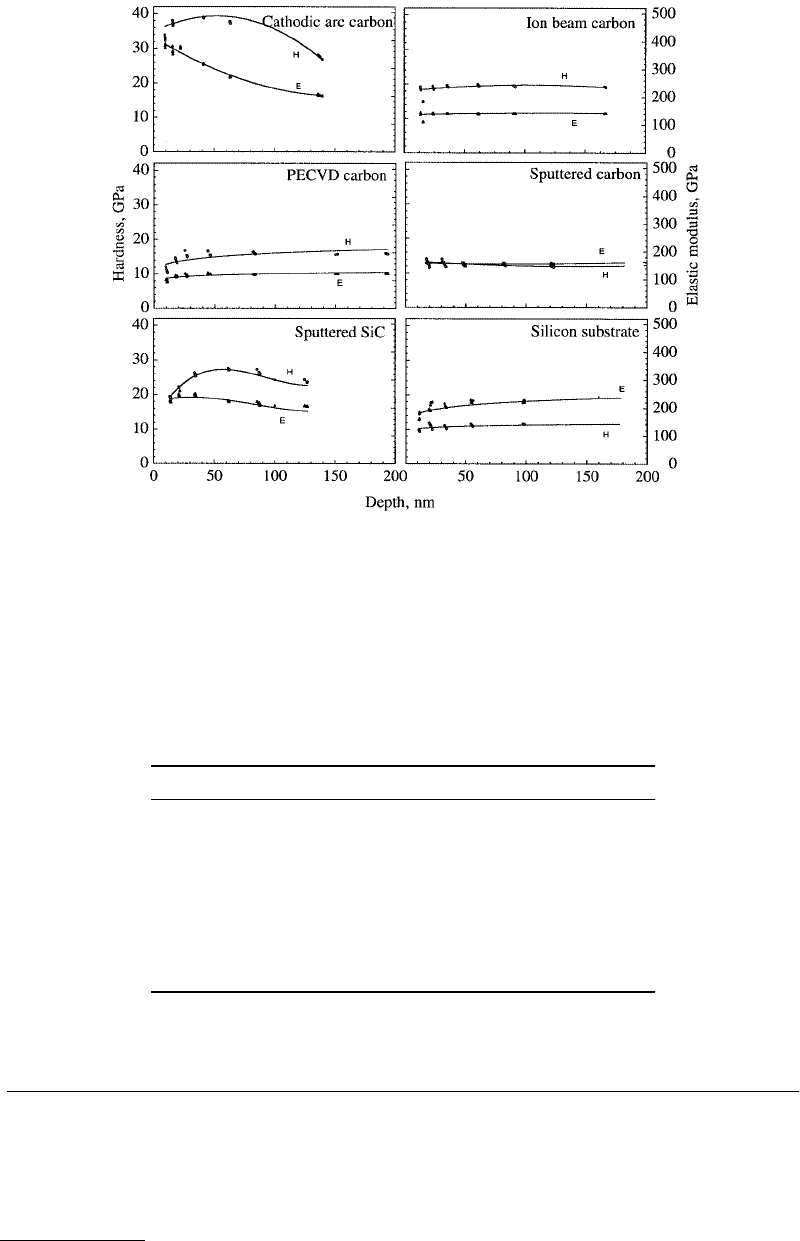
© 1999 by CRC Press LLC
10.5 Microscratch Resistance Measurement of Bulk
Materials Using Micro/Nanoscratch Technique
Microscratch technique is commonly used for screening of bulk materials for wear resistance. As stated
earlier, normal load applied to the scratch tip is gradually increased during scratching until the material
is damaged. Friction force is sometimes measured during the scratch test (Bhushan and Gupta, 1995;
Bhushan et al., 1996). After the scratch test, the morphology of the scratch region including debris is
FIGURE 10.48 Hardness and elastic modulus as a function of indentation depth at the peak load of 400-nm-thick
carbon films deposited by cathodic arc, ion beam, PECVD, and DC-sputtered and 400-nm-thick and RF-sputtered
SiC film on single-crystal silicon substrates. Hardness and elastic modulus profiles for single-crystal (100) silicon are
also included for comparison. (From Gupta, B.K. and Bhushan, B., 1995, Thin Solid Films 270, 391–398. With
permission.)
TABLE 10.5 Comparison of Hardness and Elastic Modulus of Various
400-nm-Thick Coatings Measured by Nanoindentation and Bulk Samples
Data Reported by Other Researchers
Coating Hardness (GPa) Elastic Modulus (GPa)
Cathodic arc carbon (a–C) 38 300
Ion beam carbon (a–C:H) 19 150
PECVD carbon (a–C:H) 17 140
DC sputtered carbon (a–C:H) 15 140
Bulk graphite (for comparison) Very soft 9–15
Diamond (for comparison) 80–104 900–1050
Ion beam sputtered Al
2
O
3
8.3 140
RF sputtered SiC 27 255
Single-crystal silicon (bulk) 11 220
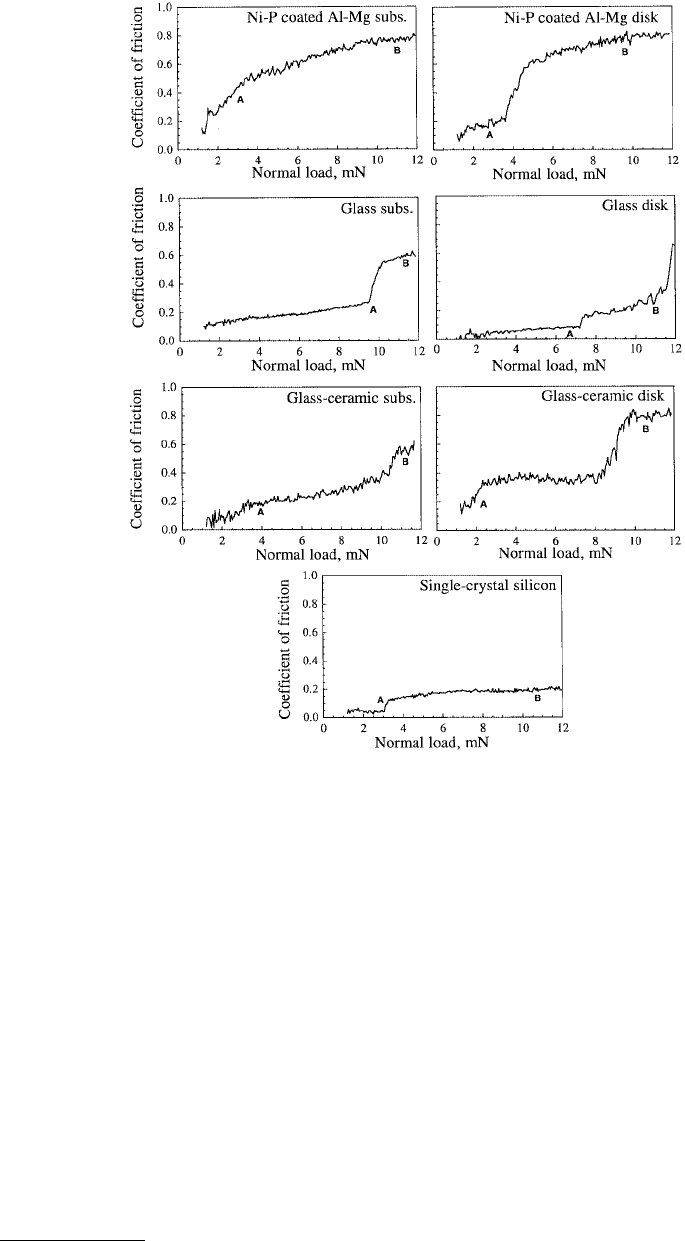
© 1999 by CRC Press LLC
observed in an SEM. Based on the combination of the changes in the friction force as a function of
normal load and SEM observations, the critical load is determined and the deformation mode is inden-
tified. Any damage to the material surface as a result of scratching at a critical ramp-up load results in
an abrupt or gradual increase in friction. The material may deform either by plastic deformation or
fracture. Ductile materials (all metals) deform primarily by plastic deformation, resulting in significant
plowing during scratching. Tracks are produced whose width and depth increase with an increase in the
normal load. Plowing results in a continuous increase in the coefficient of friction with an increase in
the normal load during scratching. Debris is generally ribbonlike or curly, whereas brittle materials
deform primarily by brittle fracture with some plastic deformation. In the brittle fracture mode, the
coefficient of friction increases very little until a critical load is reached at which the material fails
catastrophically and produces fine debris, which is rounded, and the coefficient of friction increases
rapidly above the critical load.
The coefficient of friction profiles as a function of normal load for scratches made on various ceramic
substrates and corresponding magnetic disks (substrates coated with 75-nm-thick sputtered Co–Pt–Ni
FIGURE 10.49 Coefficient of friction profiles as a function of normal load for 500-µm-long scratches made using
a diamond tip with 1-µm tip radius, at a normal load ranging from 1 to 12 mN on various ceramic substrates,
corresponding magnetic disks, and single-crystal silicon. (From Bhushan, B. and Gupta, B.K., 1995, Adv. Info. Storage
Syst. 6, 193–208. With permission.)
